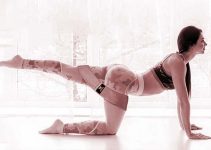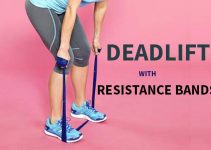Knees are among the most used joints of the body. Besides bearing the weight of the whole body, they make many angular maneuvers to enable you move around and perform in sports. When injured, there is a list of resistance band exercises you can use to help the knee recover fast.
The best resistance band exercises for your knees include lying hip extensions, lying knee extensions, stork stance TKE, terminal knee extensions, front leg extensions, lying glute extensions, bridges, standing side leg raises, crab walk with resistance band, and seated knee extensions.
You don’t have to be injured to perform these exercises. You can perform them as part of your warm up routine or when you have joint problems like in the case of arthritis and other conditions.
10 Best Knee Resistance Band Exercises
To keep your knees in good condition, you need to stretch and compress them in equal measure. Before performing the exercises below, ensure your doctor has approved of them if you’re recovering from an injury. This helps avoid further damage to the knees.
The exercises are as follows:
1. Lying Hip Extensions
The knees work hand in hand with your hips to provide you with the needed movements. For this reason, most knee exercises require the input of the hip and that’s why the first exercise on this list works on both the hip and the knee. It’s performed in the following steps:
- Lie on your back with a band in your hands.
- Loop it below your right foot then bring the knee of this foot as close to your chest as you can. Keep the lower leg horizontal at all times. At the start, your forearms should be perpendicular to the ground with the elbows touching the ground.
- Push the knee towards the other foot as much as you can while holding unto the ends of the hand.
Perform 3 sets of between 10 to 15 reps on each leg.
2. Lying Knee Extensions
Similar to the lying hip extensions, the lying knee extensions work on one foot at a time. While you moved the knee and hip in the lying hip extensions, only the knee moves in this one as in the steps below:
- Lie on your back, legs straight and band in your hands.
- Loop the band under the right foot while bringing the right knee close to the chest. After this, return the knee back such that the upper leg (thigh region) is perpendicular to the ground and the knee forms a 90-degree angle. Your elbows, which are rested on the ground besides your body, should be forming 90-degree angles as well.
- Slowly and steadily move the lower leg upwards (without moving the upper leg) until your leg is straight upwards. Return to the starting point for a single rep.
This exercise is best for stretching and strengthening the hamstrings for more flexibility. Perform 3 sets of 15 reps on each leg.
3. Stork Stance TKE
To increase the strength in your quad and shin, the stoke stance TKE exercise is among the very best. It’s a simple exercise much like doing a one-legged squat. It borrows its name from how storks and flamingoes stand on one foot with the other tucked away. You perform it as follows:
- Anchor the band at your knee level then loop the other end around your right knee while facing the anchor.
- Move backwards until you can feel medium level tension on your knee when the knee is slightly bent.
- Lift up the left leg such that you’re balancing on the right leg at the starting point.
- Slowly straighten the right knee and, in the process, pull on the resistance band. When you bend this knee again, one rep will be complete.
Perform 3 sets of 15 reps on each leg.
4. Terminal Knee Extensions
Another exercise focused on strengthening the quadriceps and shin of your legs is the terminal knee extensions. This workout is simply the stork stance TKE but without the balancing act. As such, it’s the easier version of the above exercise.
It’s performed as follows:
- Anchor the bend at your knee level then loop the other end around your right knee. Move back a step or two or until you feel medium tension in the band when you’ve bent the right knee a bit. Ensure that both feet are level at the toes.
- Straighten the foot backwards until it’s straight up and in line with the other one. Bent the knee as in the starting position for a complete rep.
For this exercise, perform 3 sets each with 15 reps on each leg.
5. Front Leg Extensions
In the early stages of your recovery process, you want to put as little pressure on your injured knees as possible. One of the best exercises in this period is the front leg extension. In this exercise, your exercise leg doesn’t bear the weight of the body and the tension of the band is shared between the knee and lower leg.
The steps are as follows:
- Anchor the band at the ankle level then loop the other end around your ankle while facing away from the anchor.
- Move a step away from the anchor or until you feel medium tension from the band in your ankle.
- Slightly bent both knees with your feet on the ground then balance your body on the foot without the band. Let the leg with the band at its ankle come off the ground a little.
- Move the leg back and forth in a kicking motion while only moving from the knee level downwards.
This exercise will make your quadriceps stronger and build the flexibility of your knee without taxing it too much. It’s also done in 15 reps and in 3 sets for a single leg.
6. Lying Glute Extensions
Your glute muscles dictate how much wide you can spread your legs to either side. To work this parts of your legs, the lying glute extension is what you need. It’s quite close to the lying hip extensions exercise but for the angle of tilt on your leg. It’s done with the following steps:
- Lie on your back with a band in your hands. Loop the end under the sole of the exercise foot then bring it above you at a 90-degree angle to the ground. When you pull on it, pull the band such that the upper leg remains upwards while the lower leg bends towards the opposite leg.
Ensure that you only pull the leg up to a safe angle to avoid damaging the knee or other delicate part. It helps loosen the hamstrings for better flexibility.
For this exercise as well, perform 3 sets each with 15 reps.
7. Bridges
Bridges are great for working your midsection all the way to your knees. For this exercise, you’ll be performing a hybrid of the lying glute extensions but at a limited angle and with the help of the back as follows:
- Lie on your back with your hands besides your body. Bring your feet together but your knees should be as far apart as comfortably possible.
- Loop a resistance band just above your knees and hold some tension in it. Your upper and lower legs should both form 45-degree angles with the ground.
- Lift your hips upwards until there’s a straight line from your knees to your neck. As you push the hips upwards, push the knees away from each other as well. Return to the starting point to complete the rep.
This exercise has many benefits given that it touches many areas in your midsection such the abs, butt, glutes, knees, lower back and hips.
Perform 15 reps in 3 sets.
8. Standing Side Leg Raises
Remember the front leg extensions? The standing side leg raises are similar but while facing to the side rather than away from the anchor. This workout helps the glutes and inner knee sections for better recovery. The process is also similar as shown below:
- Anchor the band at the ankle level then loop the other end of it around your ankle while facing on the side from the anchor. In this case, if you’ve looped the band on your right foot, the anchor should be on your left.
- At the starting position, your feet should be shoulder width apart and the band has some tension in it.
- Shift the weight of the body on the leg without the band then move the leg with the band away from the anchor on a straight line. Let the leg go away as far as possible without affecting the upright posture of the rest of the body for the best results.
For even better results, let the leg hang for 5 seconds before returning to the starting point. Perform 3 sets of 15 reps on each leg.
9. Crab Walk with Resistance Band
Perhaps you’ve noticed that crabs at times walk sideways rather than directly forwards or backwards. This exercise is based on that sideways motion. It requires the resistance from a resistance band and the bending of the knees to make it effective. It’s done as follows:
- From a standing position, loop the resistance band just above your knees then widen your legs such that the band has some tightness.
- Go to a quarter squat position with your hands akimbo then take a step directly to the left. Move the right leg so that the shoulder width between the legs is restored. Make these kind of steps until you’ve made 10 of them to one side before going the other way.
This routine will build strength and resilience in your knee area.
10. Seated Knee Extensions
The front leg extensions exercise has another variant which is the seated knee extensions. This exercise is best for when you’re at your earliest stages of recovery after an injury for example. It’s done as follows:
- Sit upright then anchor the band on the chair of the foot right next to the exercise leg at the ankle level. Tie the other end of the band on your ankle. Your knees should be at a 90-degree angle with your feet perpendicular to the ground.
- Extend the knee outwards and forewords until that leg is parallel to the ground then return it to the starting position for a rep.
Perform 3 sets each with 15 reps for each leg.
These simple workouts are best done on a consistent basis to attain the needed results. Ensure that you stay safe by not forcing the knees beyond your comfort zones to avoid injuries.
Video
Best Resistance Bands for the Knees
If you’re in the market for the best resistance bands for your knees, the following list has some of the very best:
1. Tribe Resistance Bands Set
2. REEHUT Single Resistance Band
3. Lim Resistance Bands Exercise Loops
4. FOMI 7 Ring Stretch and Resistance Exercise Band
5. Koncle 11 pcs Resistance Band Set
With these bands, you can easily vary the difficulty of your workouts by increasing the number of bands per session. Even better, some of the bands are labeled with the amount of resistance they have in terms of pounds or kilograms.
Further Reading
- Resistance Bands Basics: Meaning, Types, how they Work + Benefits
- Resistance Band vs Free Weights
- Best Beginner Resistance Band Exercises
- Dead Lift Resistance Band Exercises
- Pilates Resistance Band Exercises
- Best Ankle Resistance Band Exercises
- Best Senior Seated Band Exercises
- Best Shoulder Resistance Band Exercises
- Chest Resistance Band Exercises for Men
- Glute/Butt Resistance Band Exercises for Women
- Upper and Lower Back Band Exercises
- Resistance Band Exercises for Arms(Biceps & Triceps)
- Best Resistance Band Abs Exercises
- Best Resistance Band Leg Exercises


